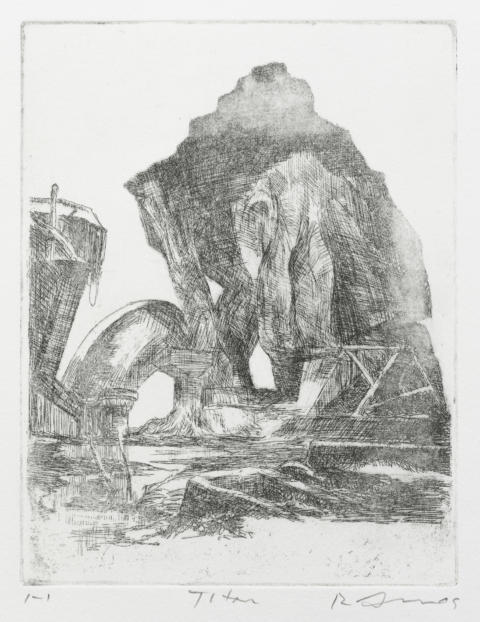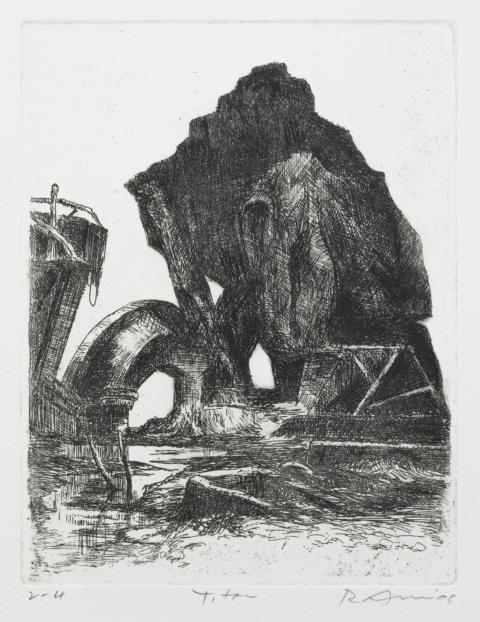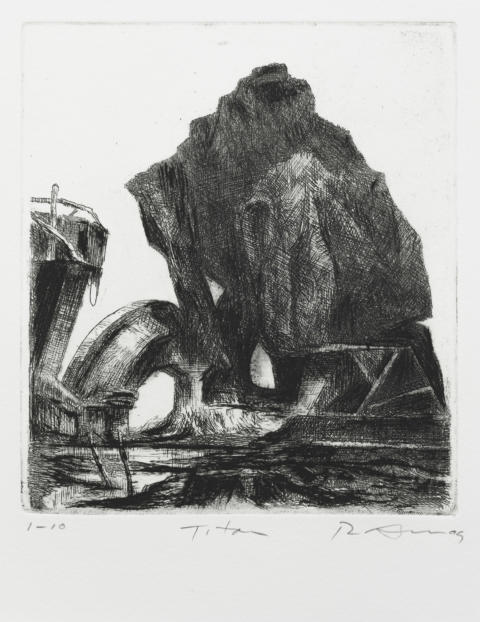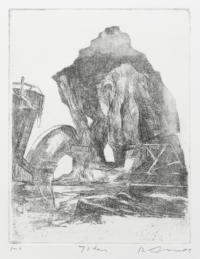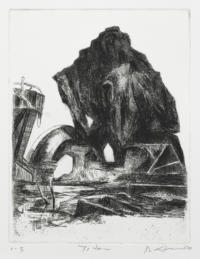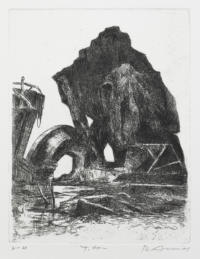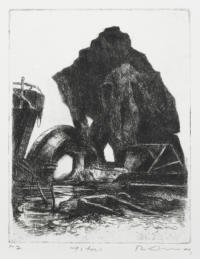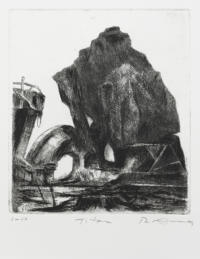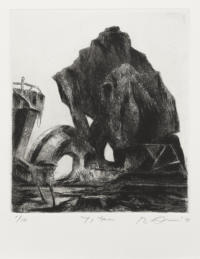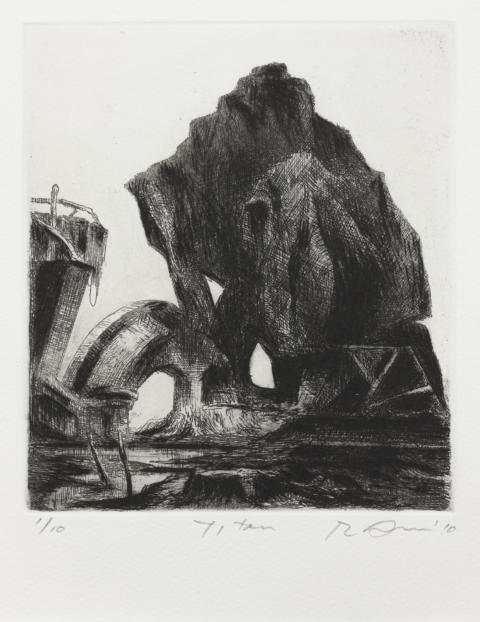
Etching. A surreal grouping of giant manmade and imagined elements in a watery wasteland, with pools of water and half-submerged building rubble. The scene is dominated at the right by a quasi naturalistic rock formation, to the left of which is an arched fragment that links the rock with what looks like a derelict pier. The subject is closely etched with cross-hatching. There is an irregularly shaped un-etched area at the bottom of the plate. The plate measures 204 x 158 cm.
Drypoint has been added to many areas of the composition, intensifying the depth of the shadows and clarifying contours. There are two variant impressions of this state.
The uneven ground at the bottom has been extended towards the plate mark with irregular loops and squiggles of etching. There are five variant impressions of this state.
A series of short parallel vertical strokes now delineate reflections in the water below the central pillar. Delicate horizontal etched strokes have been added to the vertical reflections below the two sticks at the lower left; however, some of the watery reflections in that area have been burnished out. There are three variant impressions of this state.
The plate has been cut along the bottom edge and now measures 180 x 160 mm. The partly submerged rectangular rubble is no longer visible, having been covered by areas of drypoint scoring. Drypoint accents have been added to many areas of the plate and have reshaped the pool of water at its edges. There are two variant impressions of this state.
A series of short oblique parallel drypoint strokes have been added to the modelling of the arch at its left.
- Catalogue Number
- E.158
- Title and Date
- Titan
2009–10
- Description of Featured Image
- A surreal grouping of giant manmade and imagined elements in a watery wasteland, with pools of water and half-submerged building rubble. The scene is dominated at the right by a quasi naturalistic rock formation, to the left of which is an arched fragment that links the rock with what looks like a derelict pier. This is an impression taken from the cut plate.
- Where Made
- Alphington, Melbourne
- Medium Category and Technique
- Intaglio Print: Etching and drypoint on copper
- Support
- Wove paper. Identified papers: BFK Rives paper with watermark: ‘BFK RIVES / FRANCE’ with infinity symbol; Arches paper.
- Dimensions
-
Image size: 204 x 158 mm
Matrix size: 180 x 160 mm - Artist’s Record Number
- RAE.187
- Printer(s) and Workshop(s)
- States I through IX printed by Rick Amor in his Alphington studio. State X, and edition, printed by Rosalind Atkins at Around the Bend Press (Murray Walker’s studio), Northcote (Melbourne).
- Summary Edition Information
- Ten states. Edition (printed after plate cut down) of ten numbered impressions, 2010.
- Exhibitions
- Niagara Galleries 2010: Niagara Galleries, Richmond (Melbourne), Rick Amor: Watercolours, Prints, Drawings, Sculptures & Paintings, 31 August – 25 September 2010, no. 14, ed. 6/10.
- Liverpool Street Gallery 2010: Liverpool Street Gallery, East Sydney, Rick Amor: 2010 Paintings, Watercolours, Prints, 2–28 October 2010, no. 8, ed. 6/10.
- Literature
- For an illustration of the painting related to the etching, see Liverpool Street Gallery, Rick Amor: 2010 Paintings, Watercolours, Prints (exh. cat.), Liverpool Street Gallery, East Sydney, 2010, n.p., cat. no. 9.
- Collections
- State Library of Victoria, Melbourne: eighteen state impressions, numbered 1-1, 1-2, 2-2, 1-3, 2-3, 1-4 through 4-4, 1-5, 2-5, 1-6 through 1-8, 2-8, 1-9, 1-10, 2-10, all dated 2009; three state impressions, numbered 1-11, 2-11, 1-12, all dated 2010; ed. 2/10, dated 2010.
- Art Gallery of South Australia, Adelaide: ed. 4/10, dated 2010 (20155G151).
- Comment
This is the last etching that Amor started in 2009 and he worked on it through early 2010. The composition was inspired, initially, by a painting by Diena Georgetti (b. 1966) – When I’m suffering, bring me an animal, I don’t care if it’s alive or dead, 2005 – which Amor sketched from a reproduction; his sketch is dated 17 December 2008. However, in the works that followed, little remained of Georgetti’s painting, beyond a sense of the monumental scale of the central motif and its grounding in space.
Instead of proceeding from Georgetti’s invention, Amor abruptly shifted to collage, constructing an image from a cut-up photograph of one of his own paintings, and adding to it reproductions culled from colour magazines. Next, he scanned the collage and printed it on a colour laser printer. A printout was then squared for transfer, and the image was taken first to a copper plate, for etching, and then to paper, as the basis for a large charcoal drawing.
It is clear that from early 2009 the artist intended to make painted, etched and drawn renderings of the subject – a thumbnail sketch for a painting was made on 1 February 2009, and one for the present etching on 24 May. The tiny sketch for the etching is included on a page in a sketchbook with other small sketches, under the heading ‘Etchings to do’. A thumbnail sketch of the drawing is dated 12 September 2009.
The first seven states of the print show the incremental shaping of the physical bulk of the subject in the space it occupies. With the cutting of the plate in the eighth state, the sense of space and distance collapsed and the subject was suddenly brought up close. This final version of the etching became the basis for a small study in oils (painted in August 2009), which was followed by a large painting, subsequently destroyed by the artist.
The various versions of Titan are a perfect example of the often complex interdependence of the media in Amor’s work, of the unexpected sources of some of his images, and of his persistence with certain motifs.
- Keywords
- Collage, Diena Georgetti, Surrealism
- URL
- https://catalogue.rickamor.com.au/works/intaglio/titan/
Record last updated 17/02/2021
